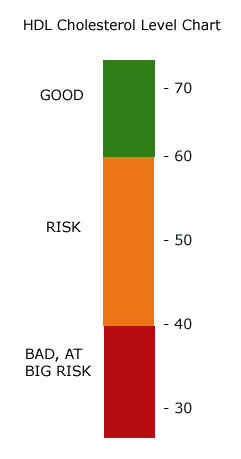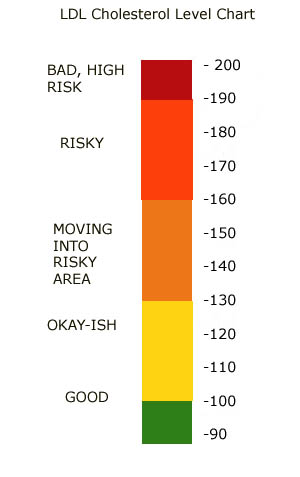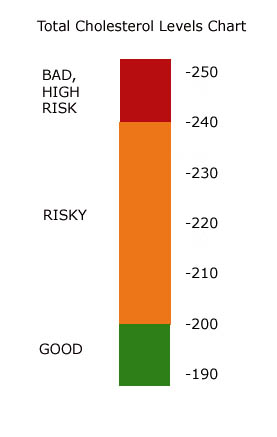Guide to Understanding Cholesterol Numbers, the Healthy Cholesterol Ratio and How to Read a Cholesterol Chart
It can be hard to understand the cholesterol numbers on the cholesterol food chart, much less what your doctor is saying when he tells you, “Your total cholesterol is 240, your HDL is 35, your LDL is 170, and your triglycerides are 350.”
What do these cholesterol values mean, and what do the results of the cholesterol blood test tell you?
If you have a hard time understanding cholesterol and the cholesterol chart, never fear.
This page on cholesterol numbers will answer the question “What is cholesterol”, will help you to understand about cholesterol in food, teach you about a good cholesterol ratio and cholesterol range, will help you to understand about the importance of a cholesterol blood test, and how you can maintain good cholesterol levels.
By the time you finish reading this page, you will know exactly what all the cholesterol numbers really mean.
What is Cholesterol? Cholesterol Is Needed by Your Body!
Before we can get down to brass tacks and learn about what the cholesterol numbers really mean, you have to understand what cholesterol is in the first place.
Many people have the misguided idea that cholesterol is all bad, but the truth is that cholesterol is needed by your body. It is a lipid that your body actually requires in order to function properly, and without it your body won’t work well.
Serum cholesterol is produced in your liver, and dietary cholesterol is consumed in the stuff you eat.
Your body uses both types of cholesterol to balance out the cholesterol levels in your body, which helps your body to work well.
Think of cholesterol as the grease that oils the cogs of your body’s inner mechanisms, and you have an idea of what cholesterol does.
As mentioned above, cholesterol is needed by the body to function properly, but it is when the cholesterol gets out of control that problems start to arise.
Imagine using a piece of gristle or meat to oil your engine rather than regular oil, and you can get an idea of what happens when your cholesterol levels get too high.
Understanding Cholesterol and Your Heart
Your heart actually has nothing to do with the production of cholesterol, but it is responsible for circulating the serum cholesterol through your body via your bloodstream.
When all goes well, your heart is happy to do its job with no complications, and you are one healthy and happy camper thanks to the cholesterol keeping your bodily functions working properly.
There are three types of cholesterol
HDL Cholesterol Is the Good Stuff
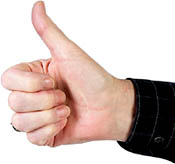 HDL cholesterol works to get rid of any bad cholesterol, as it transports it back to the liver and shunts it right out of the body.
HDL cholesterol works to get rid of any bad cholesterol, as it transports it back to the liver and shunts it right out of the body.
LDL Cholesterol Is the Bad Stuff
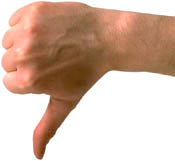 LDL cholesterol may cause problems, and this is the type of cholesterol that you want to watch out for.
LDL cholesterol may cause problems, and this is the type of cholesterol that you want to watch out for.
Triglycerides Are the Black Sheep of the Family
 Few people remember that this is a dangerous kind of cholesterol as well.
Few people remember that this is a dangerous kind of cholesterol as well.
When the Cholesterol Levels Are out of Sync
When your HDL cholesterol levels are high enough, your heart continues to function undisturbed by all the cholesterol in your blood, as the cholesterol is controlled and thus doesn’t cause problems.
However, if the LDL cholesterol level or the triglycerides level gets out of control, the total cholesterol level in your body goes up.
High total cholesterol numbers lead to dangers, and the HDL cholesterol is unable to get rid of all the bad cholesterol on its own.
The Consequences of too Much Bad Cholesterol
Once the bad cholesterol starts to accumulate in the bloodstream, problems begin to arise.
Sometimes the cholesterol sticks to the walls of the arteries, and it hardens into plaque. This plaque can crack the walls of the arteries, which can cause serious bleeding and clots.
Even if the plaque doesn’t break, it will clog up the arteries and prevent enough blood from flowing through them.
Not enough blood means the muscles in the area are not getting enough oxygen, meaning that the muscles begin to die. If those muscles happen to be either the heart or the brain, you are in serious trouble.
Cholesterol Numbers: All About the Food Cholesterol Chart
A cholesterol chart is a visual aid designed to help you learn more about cholesterol numbers.
There is the cholesterol chart that will help you to determine what levels your cholesterol is at (see below for more information on this chart), and there is the cholesterol food content chart that will help you to find out just how much cholesterol is in everything you eat.
By studying the food cholesterol chart, you can learn which foods are good for you. Remember that your daily dose of dietary cholesterol should be less than 300 milligrams if you are perfectly healthy, or 200 milligrams if you have high cholesterol.
By reading the chart, you can determine just how much cholesterol each food item contains, thus helping you to know which foods to eat and which to avoid.
Here are a few examples from the food cholesterol chart:
- Milk – Full fat, 1 cup contains 33 milligrams of cholesterol
- Butter – 1 teaspoon contains 11 milligrams of cholesterol
- Tofu – ½ a cup contains 0 milligrams of cholesterol
- Beef Liver – 3 ½ ounces contain 389 milligrams of cholesterol
- Chicken – Skinless, 3 ½ ounces contain 85 milligrams of cholesterol
These are a few examples of items on the food cholesterol chart, and there are many more food items that you would do well to study up on.
This way, you can know exactly how much cholesterol you are getting in your diet, and can take steps to control your dietary cholesterol intake in order to keep your total cholesterol levels low.
Where Is the Cholesterol in Food From? The Transformation of Fats!
But why does beef liver contain more than ten times the cholesterol that low fat milk contains?
Where is all this cholesterol in food coming from?
The thing that causes cholesterol to be present in your food is fat, the greasy, delicious thing that makes bacon, beef steak, and sausage so tempting and so terrible for your cholesterol levels.
Fat is harder for the body to process, and the body usually turns it into cholesterol to keep the body’s mechanisms greased. Just enough fat helps to oil the gears smoothly, but too much fat makes it impossible for the body to digest everything.
When the body can’t digest all the unhealthy fats, it turns it into LDL cholesterol that causes the heart problems.
The unhealthy fats like trans fats and saturated fats go straight to your arteries, and you will create a lot of cholesterol by consuming these fats. Sugar can also cause cholesterol in food, as the sugar is converted by the body to fat before anything else is.
Those that eat lots of foods that are high in fat are guaranteed to be the ones that have the highest cholesterol levels, as those foods are being converted directly into cholesterol. The lipids in the fats combine with protein particles to produce lipoproteins (the last L in LDL or HDL), and thus they are turned into cholesterol by the body.
Cholesterol Numbers: A Good Cholesterol Ratio
What does it mean to have a good cholesterol ratio or good cholesterol numbers?
If you read a normal cholesterol level chart, you will find that there is a certain cholesterol range that you need to stick to in order to be considered healthy.
If your cholesterol numbers are too high and go above that range, the chance of heart problems ranges from mildly dangerous to somewhere equaling a nuclear bomb exploding inside your chest.
For this reason, the LDL HDL cholesterol chart is so important, as it will help you to determine exactly what your LDL cholesterol to cholesterol HDL ratio is.
It may be hard to understand all the cholesterol numbers on the chart, so here is a breakdown of what the good cholesterol ratio should be, as well as what it means to have a dangerous cholesterol range on your LDL HDL cholesterol chart:
HDL Cholesterol Ratio from Good to Bad
Let’s start with HDL cholesterol, the good stuff.
When you go in for the cholesterol blood test, your doctor takes a sample of your blood and tests it to find out how high your HDL cholesterol is. The numbers will come back, and good ol’ doc will tell you:
- Your HDL cholesterol is higher than 60 – Oh boy, this is good news. If your HDL cholesterol is higher than 60, you are about as healthy as it is going to get.
- Your HDL cholesterol is between 40 and 60 – Uh oh, maybe you might want to start cutting back on the fats. If your HDL cholesterol is lower than 60, you are at a moderate risk of heart problems. Better start doing exercise and dieting to raise your HDL.
- Your HDL cholesterol is lower than 40 – Danger, Danger!!! If your HDL cholesterol dips lower than 40, it means that you are at serious risk of heart problems due to the fact that your body can’t get rid of all the cholesterol naturally.
LDL Cholesterol Ratio from Good to Bad
Now on to the LDL cholesterol, which is the “bad” stuff that can cause serious problems if it gets
out of control.
Here is what you should think when your doctor tells you:
- Your LDL cholesterol is lower than 100 – “Yipee! I have been doing everything I can to stay healthy, and it is reflected in my very low cholesterol.”
- Your LDL cholesterol is between 100 and 129 – “Hmm, okay-ish but I might have to start being careful of what I eat in order to avoid causing my cholesterol levels to get any higher.”
- Your LDL cholesterol is between 100 and 159 – “I’m getting into dangerous ground here. I had better dust off my sweat pants and start doing more regular exercise.”
- Your LDL cholesterol is between 159 and 189 – “If I don’t start being very careful and cutting back on everything that could cause high cholesterol, I am in danger of a serious heart problem.”
- Your LDL cholesterol is higher than 190 – “I had better get on it right away before I keel over from a heart attack or stroke on my way out of the doctor’s office.” (More than 190 is very high)
Total Cholesterol Ratio from Good to Bad
Your doctor will take individual readings of each type of cholesterol, but will also take a total cholesterol reading to be sure that he knows what your total cholesterol levels are.
What should you do when your doctor tells you:
- Your total cholesterol level is lower than 200 – You should hop, skip, and jump your way out of the doctor’s office thanks to the fact that you are about as healthy as it’s going to get.
- Your total cholesterol level is between 200 and 239 – You should start taking a very close look at all of your lifestyle choices and see what areas of your life need to be changed in order to lower your cholesterol before it starts getting dangerous.
- Your total cholesterol level is above 240 – You should get on your knees and pray to your god that you still have time to correct your errors before it is too late (see the final scene in Charles Dickens’ A Christmas Carol to get an idea of what to say and do in this case),as your cholesterol is very high.
Obviously some of this is over-dramatized (all in fun of course), but now you know what the cholesterol numbers mean.
How to Maintain Good Cholesterol Levels and Good Cholesterol Numbers
If you want to maintain good cholesterol levels, good for you!
The fact of the matter is that keeping your cholesterol levels in control is important, so you are doing the right thing by making the decision to keep your cholesterol levels in check.
Here are a few tips to help you get your cholesterol values balanced so you can pass the nest cholesterol blood test with flying colors:
Lose Weight
Those that are very overweight have usually been eating too much fat and sugar, so they will likely have high cholesterol.
If you want to control your cholesterol, you would be well advised to lose weight and get in shape.
Get Active
A relaxing, sedentary lifestyle can be nice, but it won’t help you to control your cholesterol. Get up off your couch, get out of your house, and start doing something that will get your heart pumping and your fat burning.
Stop Smoking
Did you know that smoking cigarettes cuts back on your body’s production of HDL cholesterol, weakens the walls of your arteries, and makes your breath smell absolutely repulsive?
You can improve your overall health (and attractiveness) by quitting cigarettes, and the effect on your cholesterol levels will be visible immediately.
Reduce Drinking
Most people love a good drink now and then, but many people find that now and then it is more than two or three times a day.
Drinking too much will cause a spike in your LDL cholesterol levels, and will lower your HDL cholesterol production.
In order to be healthy, cut back on drinking until you are having no more than one drink a day, and you will see your HDL production go way up.
Eat Right
The diet you follow has a lot to do with both your weight and your cholesterol levels, and eating right is very important in order to maintain good cholesterol levels. There are many diets that you can try, such as the TLC diet that is recommended by the AHA as the best diet to help you keep your heart healthy.
Consider Medication
Sure no one wants to take medications, but you may find that very high cholesterol numbers will force you to take some meds or supplements.
Try and go the natural route whenever possible, but you may end up taking some medications to help control your very high cholesterol if you have a history of heart disorders.
These are just a few things you can do, and you would be wise to check out some of the other pages on this site in order to know how to control your cholesterol naturally and easily.
The Importance of Getting a Cholesterol Blood Test to See Your Cholesterol Numbers
 Now that you know about cholesterol numbers, you need to realize that the cholesterol blood test is one of the most important tests you can run.
Now that you know about cholesterol numbers, you need to realize that the cholesterol blood test is one of the most important tests you can run.
By keeping track of your cholesterol numbers by going through a cholesterol tester, you can be certain that you aren’t going to let your cholesterol values get out of control.
A cholesterol monitor will ensure that you can track your LDL and HDL cholesterol to keep them both in good balance, which will help keep you healthy.
Your heart needs to be taken care of if you want to live a long and happy life, and the cholesterol numbers you get from a cholesterol blood test will tell you everything you need to know about how to give your heart the attention it needs.
Without a cholesterol test, you will never be able to know if you have high cholesterol, so get tested to be sure you don’t keel over from a heart attack or stroke.
What Would You Like to Read Now?
LDL HDL Cholesterol Chart with Cholesterol Numbers for Good Cholesterol Levels
Understanding Normal Cholesterol Levels and Cholesterol Numbers: Tips to a Cholesterol and Triglyceride Lowering Diet
Facts on Good Cholesterol Levels: Why a High HDL Cholesterol Level Is Our Friend and a High LDL Cholesterol Level Is Our Enemy
Go to the top of this article about Cholesterol Numbers
Go to the homepage Cholesterol Lowering Foods
